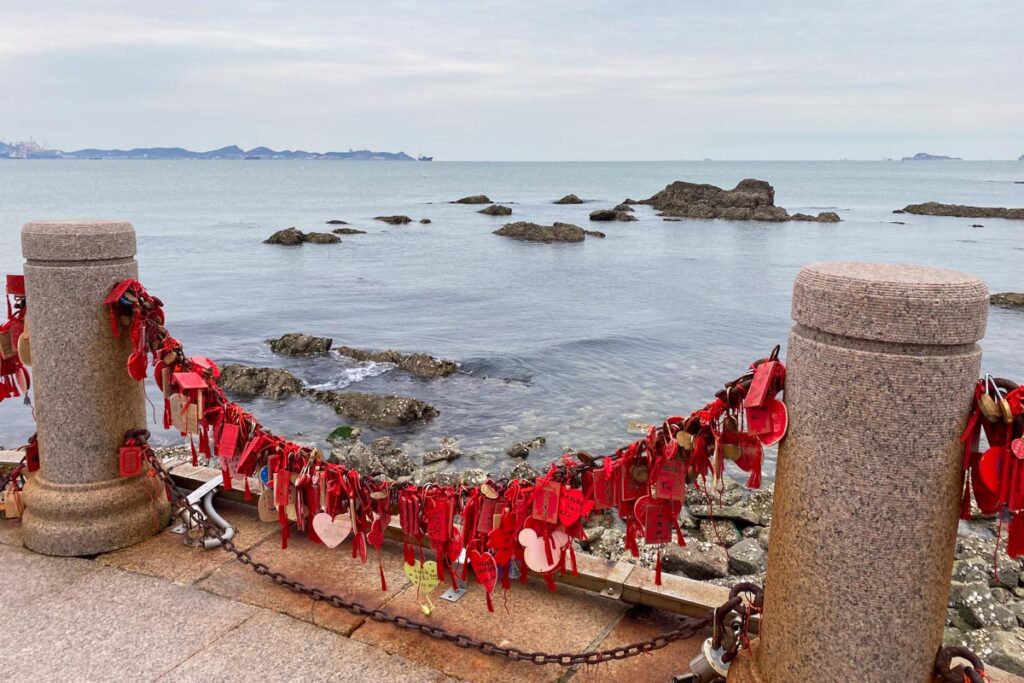After a busy fortnight packed with sightseeing in Beijing, we headed to my home city of Yantai in Shandong province.
Yantai is a mid-sized coastal city of around 2.8 million people in northeast China. Yes, a city with a population bigger than Paris is considered mid-sized – welcome to China!
You may not have heard of Yantai, but you’ve probably heard of Qingdao, or should I say Tsingtao (beer)? Qingdao is a neighbouring city in Shandong province and, you could say, Yantai’s more famous big brother. I like to joke that Shandong’s two biggest exports are Tsingtao Beer and Confucius (yes he’s also from here).
I actually spent a few years living in Yantai as a child before moving to the UK, so it’s one of the places I consider home. Although ‘home’ is a complicated concept as a third culture kid.

Although I’ve been to Beijing many times over the years, it somehow didn’t have the same lived-in familiarity of Yantai. In China, if you travel to another city outside your home province, you’ll be considered a little bit foreign (or, at least, different) by the locals – maybe akin to an Englishman visiting Scotland. It makes sense because China is so huge and there are many regional differences: the climate, the dialects, and (most importantly) the food.
In Beijing, I wasn’t a local, I was just one of the millions of faceless tourists passing through. But Yantai felt different – maybe hearing the local accent for the first time in a while evoked a sense of childhood nostalgia. Speeding along the coastal road in the taxi, I really did feel like I’d come home.
Family Time
The main purpose of my visit to Yantai wasn’t tourism, but family. Although we moved away many years ago, I still have some roots in Yantai, namely my elderly grandparents.
We used to return regularly during school and then university holidays, but visiting was logistically impossible these last few years. I’m sure you don’t need me to explain why. So… in 2023, I overcompensated with 3 visits in less than a year!
I spent a nice low-key week in Yantai, mostly enjoying quality family time. It snowed a few times, so we didn’t venture too far out.


One of my cousins also lives nearby with his family, so it was also nice spending time with them. They have a primary school-age son and, sadly, I am unavoidably an auntie now!
Seafood Bonanza
Yantai is a coastal city and famous for its seafood. I always crave it when I haven’t been back for a while. Unintentionally, we happened to visit at the perfect time of year for eating seafood.
For four months of the year, from May to August, fishing is not allowed. This is part of a nationwide effort to practise more sustainable fishing (although some may consider that to be an oxymoron). September to November, when fishing is allowed again, is the best time to enjoy wild fresh seafood in Yantai. Out of season, the seafood will be either farmed or frozen.
My cousin’s wife (cousin-in-law?) took us to a local seafood market one day. We went in the early morning, when the catch of the day was still fresh. Many things also get sold out later in the day.
The marketplace was raucous and chaotic, full of people jostling to make their purchases. It was a little overwhelming to be honest, but a worthwhile experience. Standing still for too long was a recipe for disaster – you were at risk of being splashed or whacked with something fishy.


The shellfish was very fresh indeed – still alive and wriggling. Some were piled into glass tanks pumped full of seawater. In China, many things are sold by the ‘jin’ (斤), a traditional Chinese measurement equal to half a kilogram. The prices per ‘jin’ were scrawled on bright yellow labels, and my eyes were wide at how cheap the oysters were!
We ended up with several heavy bags full of seafood – probably enough to feed us and several families over. Lunch was a delicious assortment of fresh steamed and boiled shellfish. We also ate homemade fish dumplings made from a type of mackerel (鲅鱼) – a speciality of Yantai!


Illness Brewing
Unfortunately, I woke up the next day feeling awful with a very sore throat. I’d had a mildly scratchy throat the previous day, but it had gone away, so I’d ignored it. Eating the seafood feast probably hadn’t helped (according to traditional Chinese medicine).
I checked the back of my throat in the bathroom mirror using my phone torch. And to my horror, my left tonsil was huge and inflamed with a big patch of grey. I had tonsillitis! I couldn’t believe it. I’d never even had tonsillitis as a child, so this was a bit of a shock for me.


My relatives kindly dropped off food and medicine packages for me over the next few days. It was painful to swallow, so I could barely eat. I drank a lot of ginger soup.
Our next stop was Xi’an in Shaanxi province – home of the Terracotta Warriors and indisputably the best noodles in China. I was feeling so ill that we contemplated postponing it. An 11-hour train ride isn’t fun at the best of times… But the train tickets and hotel were already booked, so I decided to persevere.
In the end, I felt relatively ok on the train, and napped for a good part of the journey. The next few days in Xi’an were about to get much worse, though.

Tonsillitis in Xi’an
I was pretty much bed-bound for the first three days in Xi’an. My sore throat got much much worse, and it became painful to even swallow my own spit. I only left the hotel to get food (this was before I’d discovered the joys of ordering takeout in China). I spent the next few days living off a diet consisting mainly of congee (Chinese rice porridge) and ice lollies. We went for noodles once and I asked for no chilli. I got a weird look from the waiter, as no chilli oil on noodles is almost criminal in Shaanxi. But it was all smiles after I explained that I was ill, and we even had a nice chat, broaching topics such as Croatian football (lol) and a German tourist who’d asked for a ‘Chinese hamburger’.
Over the next few days, the grey patch on my tonsil spread, and I also developed a constant earache. The other tonsil started to look dodgy as well. Thankfully I didn’t have a fever, so I hoped it was a viral tonsillitis that would get better by itself without antibiotics. Getting antibiotics in China is pretty easy though, and my cousin had already dropped off some cefixime “just in case”.
As a doctor, the lack of antibiotic stewardship in China (and many other countries) does make me despair slightly. When I went to the pharmacy to buy more painkillers, they tried to sell me antibiotics without me even asking.
What was much harder to find was Strepsils. I really wanted something for my sore throat, but it turns out you can’t buy Strepsils in China. Nor can you get local anaesthetic sprays like Difflam, which, ironically, I’ve prescribed for patients with tonsillitis in the past. When I asked if they had local anaesthetic spray, they looked at me like I was mad. This was the case in several pharmacies in both Yantai and Xi’an. The closest I could find was a minty not-very-effective throat spray for children.

The most effective sore throat remedy was actually a traditional Chinese medicine my cousin recommended called Yinhuang Diwan (银黄滴丸). It’s made from honeysuckle and the root of the large-flowered skullcap (or scutellaria). It comes in sachets of tiny bitter brown balls – like ice cream sprinkles, except nowhere near as appetising. They worked surprisingly well to numb the pain of my sore throat.
The tonsillitis peaked on day 5, and I was feeling much better towards the end of the week – no antibiotics needed, although I was tempted a few times. We ended up extending our stay in Xi’an to more fully appreciate the place.
A few days later, I was able to enjoy Xi’an’s famous chilli oil-topped belt noodles without my throat burning. That’s how I knew I had finally recovered from the tonsillitis.
Planning a trip to China? Check out these guides:
Paying in China
Essential Apps for China
Getting a SIM Card for China
Booking Hotels in China
Getting Around in China



Leave a Reply